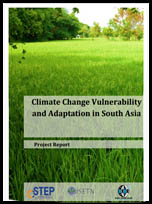Climate change vulnerability and adaptation in South Asia
 This multifaceted project implemented by four consortium partners in South Asia aims to contribute to the study of vulnerability to climate change. The research carried out at different scales, both top-down and at the local level, each using different methodologies. Areas selected for the study were two village development committees in Palpa and Kapilwastu districts of Nepal's Gandaki river basin and five villages in the Thanjavur district of Tamil Nadu, India. The overall goal of the study was to understand how vulnerability is experience in these poor communities that rely on agriculture for their livelihoods and how this would change with increasing effects of global warming.
This multifaceted project implemented by four consortium partners in South Asia aims to contribute to the study of vulnerability to climate change. The research carried out at different scales, both top-down and at the local level, each using different methodologies. Areas selected for the study were two village development committees in Palpa and Kapilwastu districts of Nepal's Gandaki river basin and five villages in the Thanjavur district of Tamil Nadu, India. The overall goal of the study was to understand how vulnerability is experience in these poor communities that rely on agriculture for their livelihoods and how this would change with increasing effects of global warming.
Related Content
- Empowering women for effective climate change adaptation: the role of the private sector
- Climate vulnerability of East Asia: adaptation in the region can provide global benefits
- State of the climate in Asia 2021
- Adaptation gap report 2022: too little, too slow
- State of gender equality and climate change in South Asia and the Hindu Kush Himalaya
- Asia-Pacific disaster report 2022 for ESCAP subregions: pathways to adaptation and resilience in South‑East Asia
